Chart 1 clearly shows that the fall in Indonesia's trade balance has been a primary contributing factor to the widening of Indonesia's CAD since early 2012, with the exogenous downturn in the global commodities cycle having a large part to play in this development. Indonesia's policymakers have long been aware that fuel subsidies have contributed to this pressure on the trade balance. By diverting national savings toward the subsidisation of energy consumption, they have distorted consumption and investment decisions and weighed on growth. Accordingly, the 2015 structural reforms removing the government subsidy on gasoline and changing to a fixed diesel subsidy will contribute positively to perceptions about Indonesia's growth potential and the sustainability of the CAD.
Even so, as Chart 2 shows, there also appears to be an emerging trend of investment opportunities in Indonesia exceeding the capacity of domestic savings' to satisfy these opportunities. Indeed, Indonesia's savings and investment rates currently exceed those in Australia and most of ASEAN (Chart 2, Chart 4), and if Indonesia's CAD is considered to be structural in nature, then so too is this relationship between savings and investment.
As noted in the previous section, close to 60 per cent of foreign investment in Indonesia appears to be directed toward sectors of the economy that are either directly related to utilising Indonesia's most prominent comparative advantages and factor endowments (mining and machinery manufacturing are the second- and fourth-largest foreign investment destinations by industry), or cater to Indonesia's exceptionally large and growing consumer market (communications, pharmaceuticals and utilities). Financing statistics for the Indonesian economy in general show a similar pattern, with credit being most prominently extended to similar sectors of the Indonesian economy.
While it is certainly the case that higher FDI typically results in a higher CAD, FDI offers many collateral benefits, such as the transfer of skills through ‘learning-by-doing'. The behaviour of portfolio flows — as a barometer of perceptions about Indonesia's CAD — has much more direct implications for Indonesia's economic stability.
As alluded to earlier, the perceptions of both exogenous and country-specific risks will influence the volatility of portfolio flows. When viewed from a savings/investment perspective, it is clear that the only way to eliminate the possibility of the vulnerabilities of capital flight arising from a CAD in the short term would be to deliberately prevent productive investments from being undertaken in the economy, by only funding investment to the level of domestic savings' capacity. This would result in reduced productive capacity and growth potential for the Indonesian economy. And indeed, it is clear that there are plenty of productive investment choices available to foreign investors in Indonesia. To be clear, this savings-investment imbalance in Indonesia is not the result of a deficiency of domestic savings.6
Mitigating country-specific risks need not be so damaging to economic performance. In a situation where markets will increasingly be re-evaluating the riskiness of investments as global monetary policy normalises, then there is a role for policy to provide transparency and clarity with regard to the macro-economy – to avoid contributing to further instability.
Let's take as a specific example Indonesia's banking system. Although it is significantly improved since the Asian Financial Crisis, it does not appear to have the capacity to intermediate all of the investment requirements of domestic businesses. As a result, businesses have resorted to seeking unhedged finance directly on the open market, creating currency risks. Microeconomic reform of the banking sector could thus have far-reaching benefits to Indonesia's economy. In this respect, the way Australia managed perceptions about its CAD during the 1980s – a period of market concern about Australia's CAD – is instructive as a basis for designing a longer-term strategy to improve the ‘stability' of perceptions about Indonesia's external position.
Chart 4: Gross investment/gross savings ratio – ASEAN region (2008-13 average)

Source: IMF April 2014 World Economic Outlook database
Chart 5: ASEAN region FDI inflow-to-GDP shares (2013)
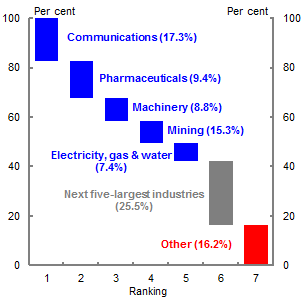
Source: National statistical agencies. Note: Thailand's data are for 2012.
Chart 6: Share of foreign investment by industry (5-year average)
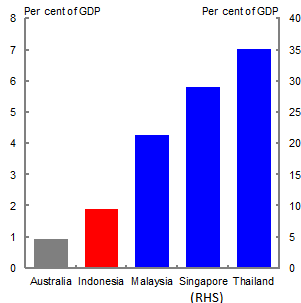
Source: Statistics Indonesia.
Chart 7: Indonesia – share of financing by sector (3-year average)
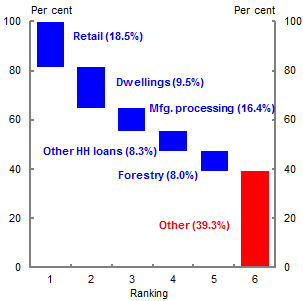
Source: Statistics Indonesia.
Box 1: Australia's experience with CADs
Australia's current account has been in deficit almost continually since official statistics began in the late-1950s (Chart A), though research by the Reserve Bank of Australia points to the current account being more often in deficit as far back as the mid-1850s (Belkar, Cockerell and Kent, 2007).
Chart A – Australia's Current Account Balance
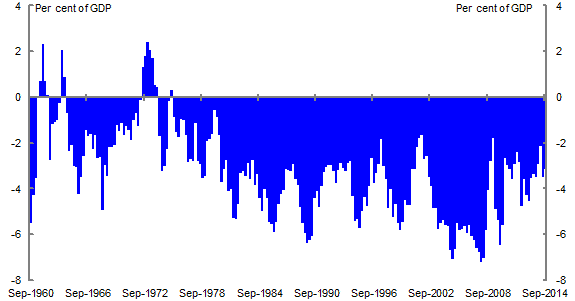
Source: ABS cat. no. 5302.0 and 5206.0.
Despite Australia's prolonged CADs, periods of capital flight have been limited. The most notable occurred during the 1890s depression after significant inflows had contributed to a property bubble. When it burst, foreign capital retreated for much of the decade — except for inflows related to the West Australian gold rush — which contributed to a banking crisis that resulted in the closure of roughly half the nation's banks (Belkar et al. 2007). Capital inflows also slowed during the 1930s depression but less dramatically than in the previous episode. Fears that Australia would be unable to meet repayments on Treasury bills issued in London and due in mid-1931 dissipated following a raft of measures, many of which entailed greater austerity, coming out of a conference of federal and state ministers that became known as the Premiers' Plan (Giblin, 1951, Gruen and Clark, 2009).
There was less concern with the current account during the period of capital controls enacted during the Second World War, which lasted into the 1970s. As the controls were progressively removed, the CAD
increasingly became problematic due to the fixed and subsequent crawling peg exchange rate regimes, given the finite level of foreign exchange reserves and periods of intense speculation that the currency would have to be devalued. After the floating of the Australian dollar in December 1983, the CAD increased, with the government focusing on fiscal consolidation and microeconomic reform to improve Australia's international competitiveness, though only in part because of their concerns about the balance of payments. Meanwhile, for a brief period in the 1980s, the balance of payments became one of several explicit targets of monetary policy.
As the economic reforms of the 1980s began to reduce rigidities within the economy, concerns about the CAD gradually diminished. The steady reduction in tariffs and other trade barriers exposed domestic industries to greater international competition, labour market reforms and subsequent policies enhanced labour market flexibility, and financial deregulation (including by allowing foreign owned banks to compete for corporate and (eventually) deposit taking business) along with reforms to the financial regulatory framework provided an environment for the private sector to manage its own financing risks.
Monetary policy eventually moved to an inflation targeting regime and the benefits of a freely floating exchange rate in absorbing some of the impact of international shocks became apparent. Through time, fewer official foreign exchange reserves were required, though there were still episodes of heavy intervention in 2001 and 2008. In recent years, Australia has had relatively high levels of saving in comparison to other developed economies, with household savings increasing since from the mid-2000s. In addition, Australia's CAD has been one of the drivers for running conservative fiscal policy – ensuring the public sector does not exacerbate the private sector position. As such, rather than being the product of insufficient domestic savings, Australia's CAD is better characterised as being the result of ample investment opportunities attracting foreign capital (Gruen and Sayegh, 2005 and Debelle, 2011), which became particularly apparent during the commodities boom.
Concerns about Australia's current account are still periodically raised by international organisations, such as the International Monetary Fund, and the credit rating agencies, though these concerns mainly focus on how Australia's current account and the accumulated net foreign liabilities from past CADs are financed. The Australian banking system has traditionally intermediated a significant proportion of the CAD, though the recent mining investment boom saw an increase in direct investment by mining companies. While a significant proportion of Australian bank funding is sourced offshore, the foreign exchange risk is almost completely hedged (Charts B and C).
Chart B – Gross foreign currency exposure by sector (per cent of GDP)
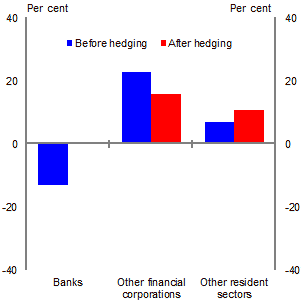
Chart C – Net foreign currency exposure by sector (per cent of GDP)

Source: Bank for International Settlements and ABS cat. No. 5206.0.
Moreover, net of hedging, Australia's foreign currency exposures are on the asset side of the balance sheet, in part reflecting the benefits of international diversification and Australia's expanding pool of superannuation assets. Accordingly, Australian dollar depreciation improves the net position. Since the global financial crisis, Australian banks have increased their sources of domestic funding, mainly in the form of deposits, and have retired some of their foreign debt.
This shift has taken place even though Australian banks have had little difficulty in accessing foreign funding – with the exception of the height of the GFC. Over this time, the term to maturity of foreign debt has been lengthened, which has increased the stability of banks' foreign funding and reduced rollover risk. In addition, the share of foreign debt denominated in Australian dollars has been increasing, though diversity in funding sources by currency remains.
6 While efforts such as recent mooted tax incentives for retained investment earnings may artificially raise the savings rate in Indonesia, it could come at the cost of stability – with these tax-incentivised savings being directed into relatively volatile portfolio investments, possibly adding to the present instability of capital flows.